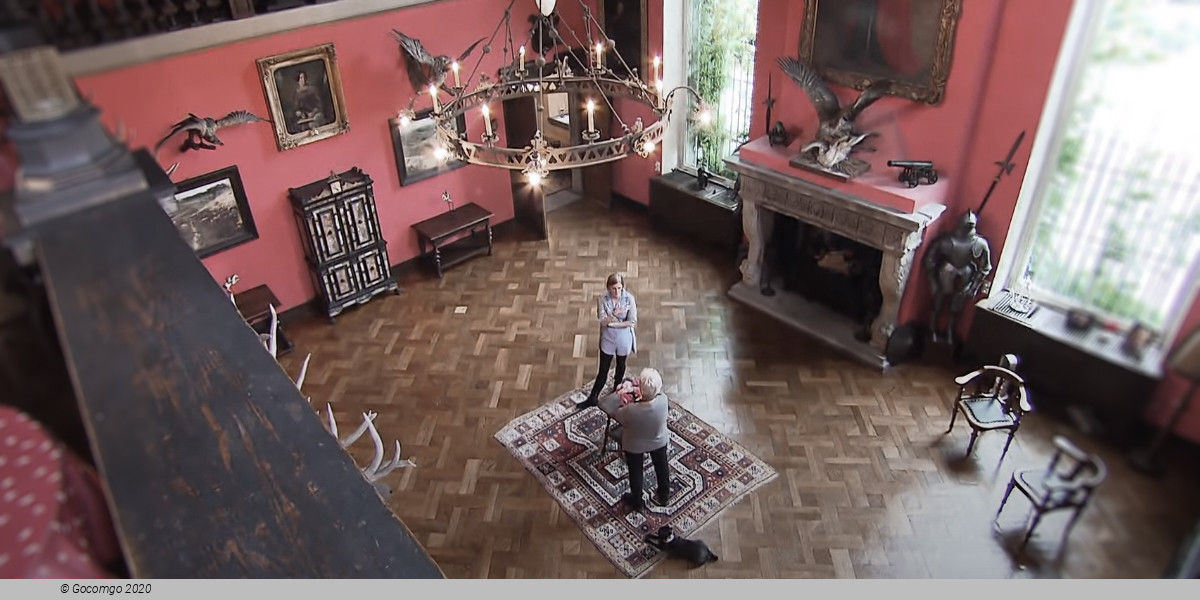Burg Namedy (Bonn, Germany)
Burg Namedy

Namedy Castle is a water castle built into a castle in Andernacher district Namedy in the district of Mayen-Koblenz in Rhineland-Palatinate.
The moated castle
The castle Namedy was built in the 14th century by the Andernach patrician family of Hausmann as a small moated castle including the Adelshof "Niederhof". The first lord of the castle Gerhardus dictus Husmann (died 1211) is known, his grave plate was formerly still in the monastery.
The Knight Mayor of Koblenz and Councilor Dr. iur. Antonius von Hausmann to Namedy (also Anton von Husmann), brother of the last abbess of Namedyer Cistercian monastery, Hildegard von H (a) usmann (1518-1562), and his second wife Margeretha to Eltz built between 1550 and 1560 from the castle. In 1633, the castle suffered from plunder by Swedish soldiers.
After the death of Friedrich Ruprecht von Hausmann in 1664, the daughter Anna Katharina brought the castle house of her family, whose male line died out in 1676, into the marriage with her husband Andreas von Klepping. He was followed by Franz Wilhelm von Klepping. The family from Klepping came from Dortmund and probably never even lived in the castle until it was sold in 1700.
The baroque castle
The Kurtrier chancellor Johann Arnold von Solemacher (1657-1734) from Koblenz bought in 1700 the manor Namedy for 7500 Reichstaler by Maximilian Melchior of Klepping, the son of Franz Wilhelm. In 1718 he was by Emperor Charles VI. raised after the addition of names and coats of arms of the old family Husmann of Namedy in the imperial knighthood. He converted the castle into a palace complex in the Baroque style. The living area was increased and two side wings added. His son Johann Hugo von Solemacher (died 1763) completed the building. In the floor plans and plans of 1709 (in the provincial capital archive Koblenz, see bibliography), the state before the extension of the building is clearly visible.
The family of Solemacher lived in the castle until the possession of the left bank of the Rhine by the French. Johann Melchior von Solemacher († 1820) fled before the arrival of the French troops with all inventory to Koblenz. After that, the building was used as a military hospital and powder magazine and thereby completely ruined. Windows, stairs Floors and doors served as fuel for the hospital, only the roof survived the demolition. For fear of war and other destructions, the renovation was not until 1856. By the marriage of Josephine of Solemacher († 1836), daughter of Johann Melchior, with the Electoral Trier Privy Councilor Christoph Josef Linz came to the possession of this family. He was followed by his son Oberregierungsrat Franz Linz in this possession. In 1896 Baron Arnold von Solemacher bought back the castle from the Linz family. In 1907, the hotel group Gebrüder Eberbach GmbH took over the building. In 1908, two Upper Silesian coal magnates, Prince Henckel von Donnersmarck and the Prince of Hohenlohe-Öhringen, bought the estate, but as early as 1909 it was sold again to a Swabian prince from the House of Hohenzollern-Sigmaringen.
Prince Karl Anton zu Hohenzollern was a lieutenant general in Prussian service and had received the indication that the castle was for sale, from his Berlin barber, who came from Andernach. He liked the building and he had through his wife, Josephine of Belgium, a sister of the Belgian king, also on the means for their acquisition. In addition, the castle was about equidistant from Sigmaringen and Brussels, the home of the couple. He had the Andernacher architect Clemens Kroth a single-storey hall of mirrors with two corner towers on the northwest wing grow. An attached hotel wing was removed. During the First World War, Princess Joséphine maintained a hospital in the Hall of Mirrors. With the German invasion of Belgium at the beginning of the First World War, however, the Belgian royal family ceased its payment payments to the wife of the German general. On his return in 1918, the prince found the castle occupied by American soldiers who were very disrespectful of his person and his inventory. He died there on February 21, 1919, at the age of 51, as the service had severely damaged his health on several fronts.
In 1919 the son Albrecht Prince of Hohenzollern took over the castle. In 1933, the stair tower and the south-east tower were given new Baroque-style domes. In 1988, the now run-down estate went to his son Godehard Prince of Hohenzollern. This began with the restoration and developed the castle into a cultural center, where concerts from classical to jazz, theater performances, and art exhibitions took place. In 2003, the restoration of the Hall of Mirrors also involved the German Foundation for Monument Protection. Since the death of Godehard in 2001, his widow Heide Princess von Hohenzollern directs the castle and cultural events.


